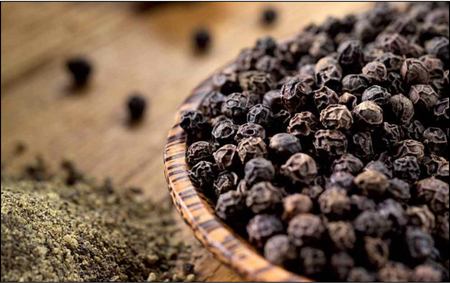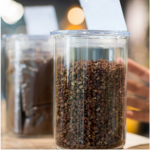BLACK PEPPER IN AYURVEDA, HISTORY, FORMATION AND EFFECT ON HEALTH
ABSTRACT
The constituents of essential oil add to the value of piper nigrum, a spice crop of great importance in Asia. It has been used historically as a fragrant aromatic, medication, and culinary ingredient. It is employed in the food, cosmetic, and pharmaceutical sectors these days. The black fruit body that develops after maturation and drying out is the plant’s most aromatic part. Piperine is an alkaloid-type compound that contributes to the taste and pungency of black pepper. Herbal medicine has traditionally utilized black pepper. Recent investigation has shown that piperine has bioactive properties as an antioxidant and anti-inflammatory agent. Its antioxidant activity also prevents food from oxidizing lipids. Both the chemical structure of pepper and the methods employed in its industrial processing are presented.

INTRODUCTION
‘King of spices’ Black pepper, botanically named Piper nigrum, belongs to the family Piperaceae, which grows in southeast Asian countries and Brazil, and the occurrence of phytoplasma disease is reported only from India. At a height of 10 meters, it is referred to as a “woody climber” due to its aerial roots. Each slender spike has 40–50 blossoms of the small flowers. On maturity, their appearance changes to green, they form a yellowish-red color, and they bear a single seed. It features a 5 mm-diameter drupe fruit known as “peppercorn.” Peppercorn color can vary from black to white to green to red, depending on harvesting and processing methods. The essential oil found in black pepper has a fragrant scent. A bioactive phytochemical compound called piperine has a wide range of physiological and pharmacological effects, such as antidepressant, anti-tumor, anti-inflammatory, anti-mutagenic, and some gastro-protective effects. Moreover, it increases the bioavailability of medications and phytochemicals like curcumin. Piperine has been shown to have immunomodulatory, antioxidant, and anti-inflammatory qualities in studies on human, animal, and modern cells.
THE HISTORY OF “BLACK GOLD”
Pepper has been grown in India for thousands of years and is the most important and widely used spice in the world. In the past, pepper was so valuable that it was utilized as currency to cover dowries, taxes, tributes, and rent. It served as a standard means of exchange and was weighed like gold. Pepper was a staple of Roman cuisine and later came to represent prestige in European cooking. For many years, only the Malabar region of India was used to grow pepper. It is interesting to note that ‘Red Pepper’ refers to a completely unrelated species (capsicum family chili peppers).
THE STRUCTURE OF PIPERINE:
Piperin’s IUPAC name is 1-(5-[1,3 benzodioxol5-yl]-1-oxo-2,4-pentadienyl), and its chemical formula is C17H19NO3. The name piperoylpiperdene is now also used for it. It hydrolyzes to produce piperidinen and piperic acid, and it is a very weak base. Piperine, which is light-sensitive, loses its pungency due to the isomerization of piperine into other forms. Piperine inhibits free radical and reactive oxygen species and lipid peroxidation due to their flavonoid and phenolic contents.

FORMATION OF BLACK PEPPER
The basic steps involved in the formation of black pepper are given below:
| Harvesting |  | In the plains of India, the crop is harvested in December and January; in the western Ghats highlands, it is harvested in January and April. The hands clip off the spikes and gather the berries in bags when one or two of the berries turn yellow or red. |
| Threshing |  | There are two kinds of threshers used: electrical power and human labor. The traditional method of trampling, which is messy, laborious, and imprecise, involves using legs. |
| Drying |  | When it comes to all spices, sun drying is the most crucial step. There is a 60–70% moisture content in the pepper. The phenolase enzyme catalyzes the oxidation of phenolic compounds by atmospheric oxygen, causing the berries to turn black. |
| Cleaning And Grading |  | The dried and threshed pepper contains foreign materials such as soil particles, spikes, pinheads, and stones. Handpicking and winnowing are the methods used to remove most of these contaminants. |
| Storage |  | The hygroscopic nature of black pepper In the event of precipitation, they take in moisture from the atmosphere, leading to the growth of mold and bugs. |
EFFECTS OF BLACK PEPPER
Piperine exhibits a broad spectrum of bioactivities. Piperine is the major pungent alkaloid identified in the fruits of P. nigrum. Phytochemical studies on black pepper have determined the presence of various minerals and vitamins (b-carotene, tocopherols, ascorbic acid, thiamine, riboflavin, and niacin), polysaccharides (arabinose, rhamnose, and galacturonic acid), volatile oils (camphenes and pinenes), alkaloids (piperin, piperidine, piperolein, capsaicin-2-dihydrocapsaicin), resins (chaviscin), and various phenolic compounds (benzamides, gallic acid, kaempferol,coumarins, and quercetin). These phytochemical and biological constituents of black pepper exhibit anti-inflammatory, neuroprotective, immunomodulatory, anti-convulsant, anti-depressant, tumor, card cardioprotective, antioxidant properties.
- Neuroprotective Effect
A recent study from 2023 shows that neurons are essential to the development and maintenance of the central nervous system. In cerebellar granule neurons (CGNs), low-concentration KCl treatment causes neuronal apoptosis in response to activity deprivation. In contrast to a major compound called piperine, studies on activity-deprived CGNs in Piper nigrum showed that oleoresin significantly increased the 3-(4,5-dimethyl-2-thiazolyl)-2,5-diphenyl-2H-tetrazolium bromide signal. When neuronal activity was removed, black pepper oleoresin consistently inhibited the activation of cleaved caspase-3, an indicator of apoptosis.
Brain aging is distinguished by altered intercellular communication, stem cell exhaustion, genomic instability, DNA changes, epigenetic changes, mitochondrial dysfunction, stress response, and cellular senescence. Because of a lack of antioxidant enzymes such as glutathione peroxidase and catalase, the brain is extremely vulnerable to oxidative stress.
The impact of black pepper on neurological conditions:
Parkinson’s and Alzheimer’s disease: Black pepper’s bioactive compounds and antioxidant capacity help maintain cognitive function and enhance brain function in AD. Oral black pepper supplementation resulted in neuroprotection, including a reduction in amyloid plaque formation and cholinesterase activity. Methanolic black pepper extracts have the ability to modulate their effects on illness. In rats, researchers discovered that methanolic black pepper fruit extract reduced oxidative stress, increased antioxidant enzyme levels, and improved memory function. Recent in vitro and animal studies have shown that black pepper, specifically the active ingredient peprine, may be beneficial in the treatment of Parkinson’s disease. Furthermore, black pepper extracts, including the fruits, pericarp, and leaves, improve cell viability and may have neuroprotective effects on 6-hydroxydopamine (OHDA). In addition, piperine treatment improves cell viability and reduces cytotoxicity in S-K-N-SH cells by promoting SNCA degradation.
- Improves Digestion
When consumed raw, black pepper aids digestion by releasing hydrochloric acid, which aids in the breakdown of proteins. This acid cleanses your intestine and keeps you from developing other gastrointestinal diseases. As a result, include a pinch of black pepper powder in your meal. This also aids in avoiding constipation.
Black pepper is also high in manganese, a mineral that aids in bone health, wound healing, and metabolism. People eat black pepper with curd to improve gut health. Lactobacillus promotes digestive health. One teaspoon of black pepper contains 6 calories, zero grams of fats and proteins, 1 gram of carbohydrate and fiber, zero grams of sugar , cholesterol, and sodium.
- Anti- Cancer
The metabolites present in black pepper extract are found to be considerable amounts of caryophyllene, a terpenoid with anticancer properties, and coumaric acid, a phenolic acid that has cytotoxic activity against various tumour conditions and has also been reported to show antioxidant, antimicrobial, and antiviral properties. PIP has been widely studied for its crucial role in cancer conditions. The bio-enhancement of various other drugs and the prevention of various chronic disease conditions. Previously, it was reported that PIP causes late apoptosis in triple-negative breast cancer cells.
- Antioxidative Effects On Cardiovascular Disease
Oxidative stress plays a significant role in the progression of cardiovascular diseases. It involves the generation of free radicals. Oxidation of lipids and proteins damages DNA, injures cellular components, initiates apoptosis, induces inflammation, and causes cell death. Several in vivo and in vitro studies have shown that black pepper terpenes increase cell viability, restore mitochondrial function, and improve antioxidant balance.
Black Pepper In Ayurveda
In Ayurvedic medicine, black pepper is known as ‘Kali mirch’ or ‘Maricha’. In India, it is one of the most commonly used herbs in Ayurvedic medicine, with well-known health benefits. One teaspoon of black pepper was used to treat gastrointestinal disorders. And even more recently, their role in treatment of chronic malaria Due to the presence of bioactive components. Every metabolite played a role.
- Gastrointestinal Disorders – Piperine is a piperidine alkaloid with a pungent flavor. Indomethacin has been linked to stomach mucosal damage in rats due to pressure. This material protects the stomach from ulcers by reducing the amount of intravenous and oral gastric juice. Indomethacin also works by lowering the levels of prostaglandins in serum and gastric tissues. As a result, piperine increases antioxidant activity and gastroprotective mucin secretion. This can also be used as an antiulcer drug, and patients taking indomethacin can include black pepper in their regular diet.
- Metabolism And Obesity – In animal studies, piperine heleped in the increment of body energy. And piperine does this by affecting the production of hormone-like chemicals that regulate energy balance. People are adding black pepper to their regular diet, which can improve their lifestyle.
- Treatment Of Skin Disorders – Several cell culture studies using pigment-producing cells from the skin showed that black pepper extracts stimulated cell multiplication and function. Piperine is also useful in treating the depigmentary disorder vitiligo. Ayurvedic medicines also help in treating certain disorders.
CONCLUSION
Black pepper contains several chemical and bioactive compounds. Piperine, the main constituent alkaloid, contains primary essential oils such as caryophyllene, sabinene, and lemonene, which are used in the food industry as natural food sources as well as in the cosmetic and pharmaceutical industries to improve therapeutic efficacy. They also have medicinal properties. These have anti-inflammatory, antioxidant, antimicrobial, and anticancer properties; they aid digestion and increase nutrient bioavailability. Black pepper contains piperine, a nutraceutical compound with pharmaceutical properties.
Numerous cell culture studies have shown that black pepper and its extracts have antioxidant and anti-inflammatory properties. Limited research has been conducted on the benefits of convulsions and strokes. To confirm health benefits, controlled human studies involving several dietary components of black pepper are also required. Another important consideration is the dose-dependence of piperine’s pharmacological effects. Although lower doses of piperine demonstrate a wide range of therapeutic activities such as anti-AD, anti-PD, and antidepressant effects, higher doses have negative effects on the body. Essential compounds include alkaloids, steroids, flavonoids, phenolics, chalcones, and various lignan derivatives, as well as terpenes extracted from black pepper. It works as an antipyretic, analgesic, and antioxidant. It has a protective effect on key liver enzymes.




